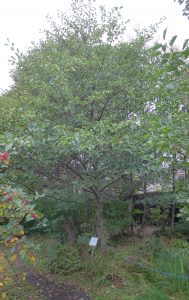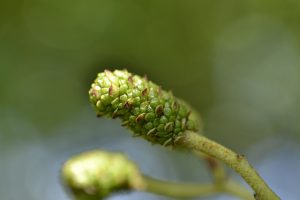Alder – Alnus glutinosa (Betulaceae)
Gaelic: fearna
Common Names: Common Alder, Black Alder
Alder is found in wet places and has a wide native range through Europe, west Asia and north Africa. It is a pioneer species of wet and marshy land, helping to open up water-logged soils and stabilising river banks, allowing other species to colonise these areas. It can be recognised by its characteristic blunt-tipped leaves, which are slightly sticky and its distinctive female catkins. The female catkins ripen to green, eventually turning into brown, woody ‘cones’, these are persistent and can be seen adorning the tree in winter. The male catkins, which grow on the same tree as the female ones, are typical of the family.
Timber from Alder is widely used as it is very resistant to rot, making it ideal for use underwater and in water-logged situations. It has been used to create piles and foundations for structures with evidence it was used to make the base of crannogs (artificial islands) at the edge of lochs and the piles of buildings in Venice and Amsterdam. It has also been traditionally used to make clog soles, with trees being coppiced on a 10-12 year cycle. It was also used to produce a range of dyes with the bark and young shoots producing yellow and cinnamon shades and catkins a green dye. The leaves are slightly sticky, which is suggested in the latin name ‘glutinosa’ and were traditionally used as fly paper, leaves were also used for tanning animal hides.
Location



2 Comments
2 Pingbacks